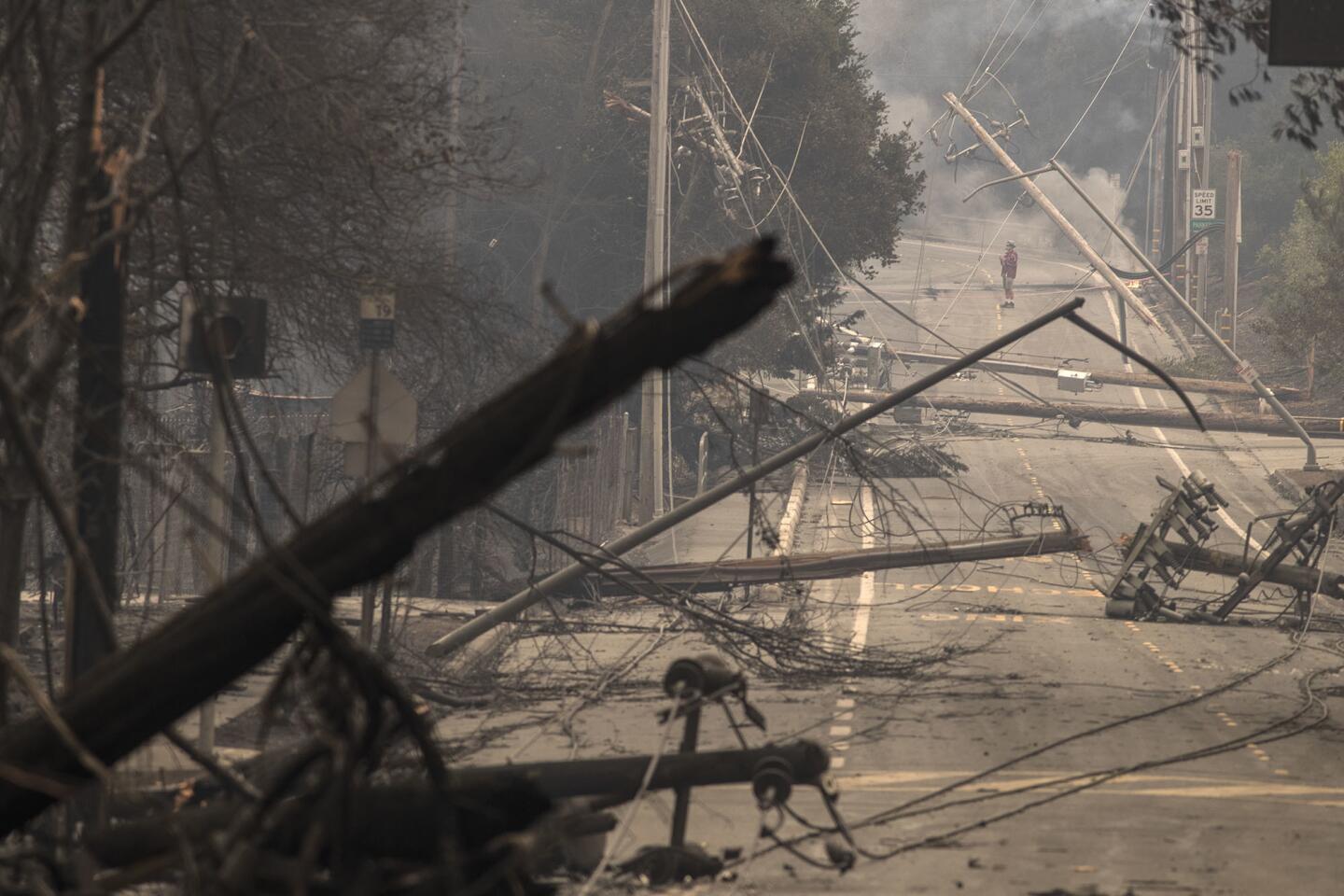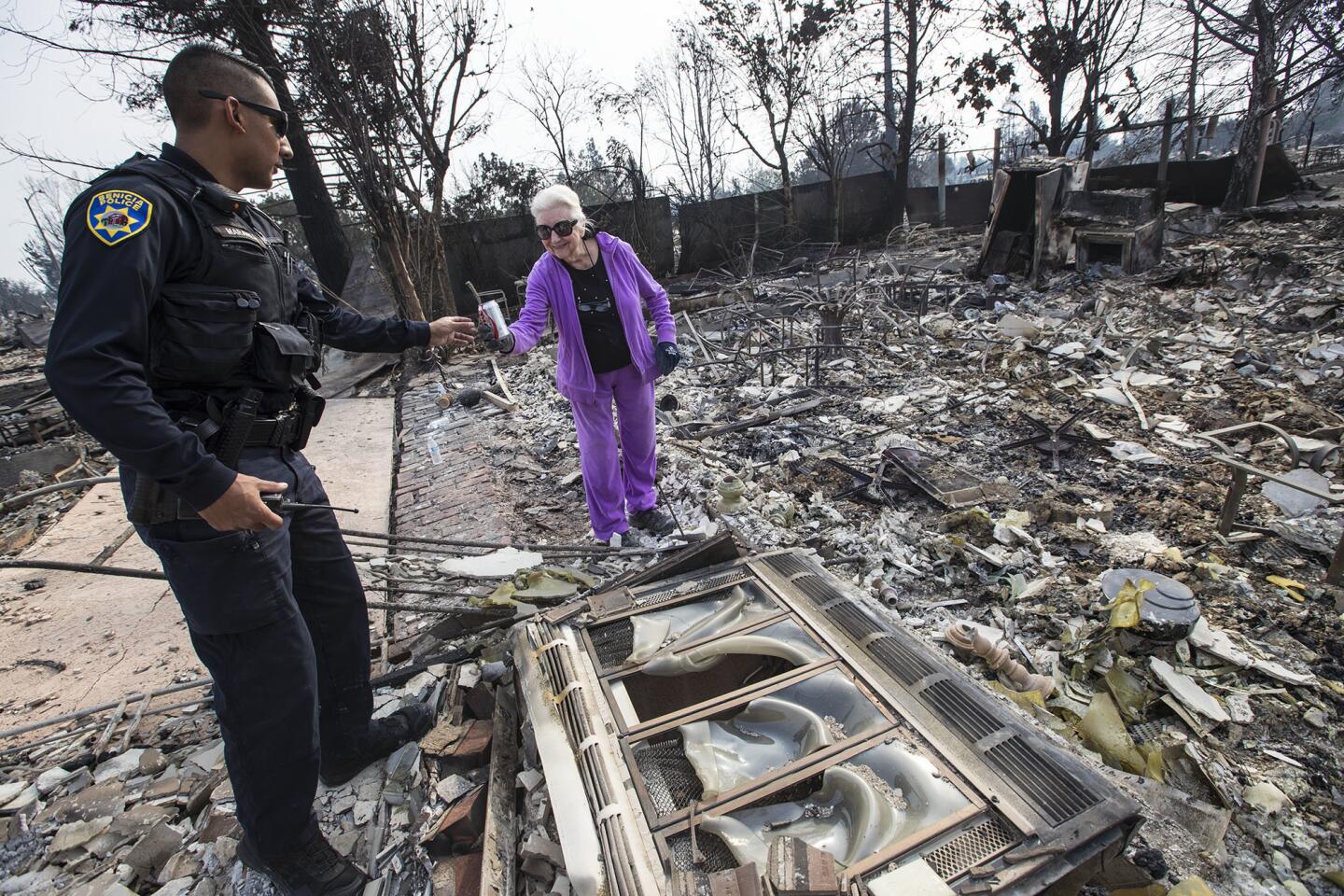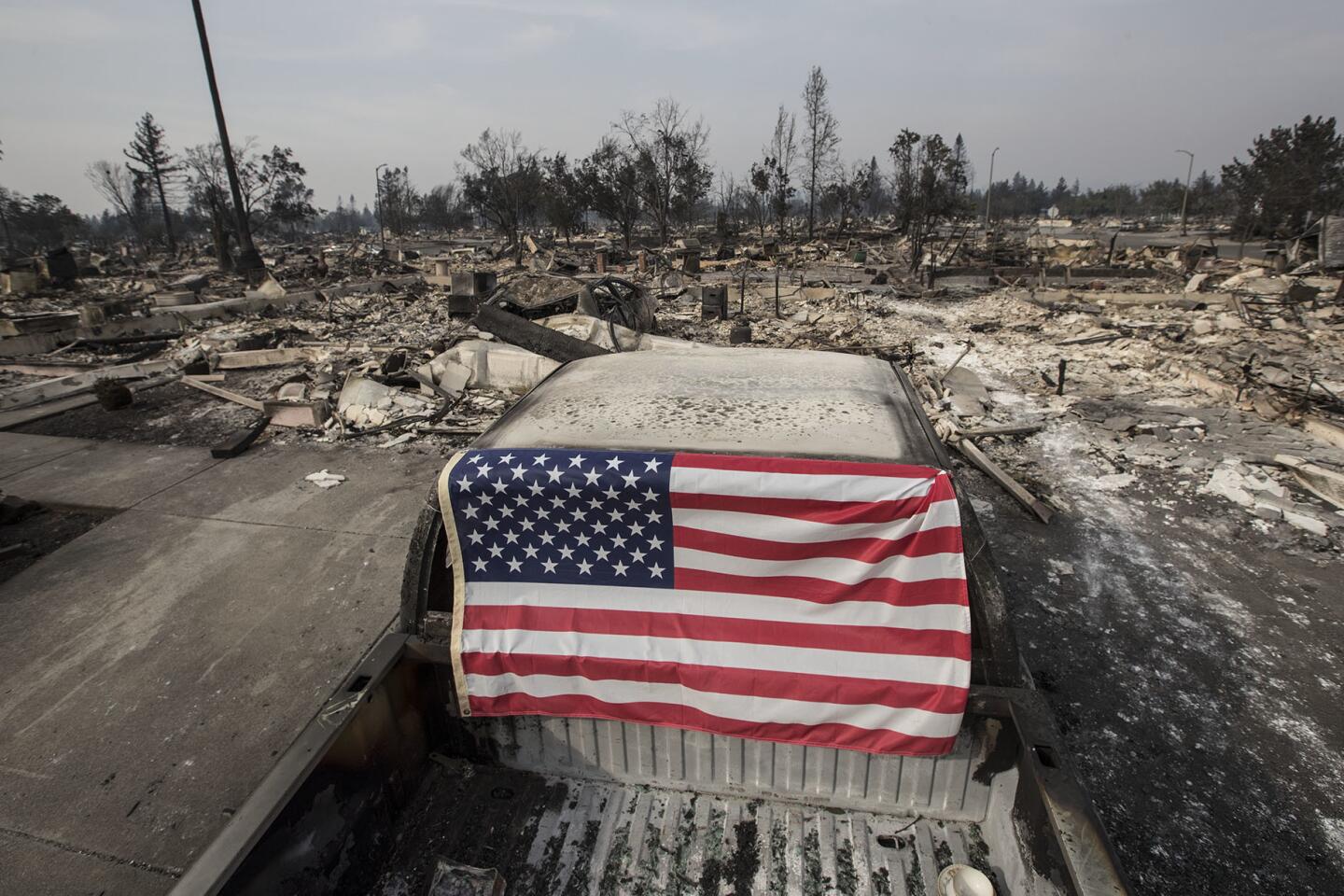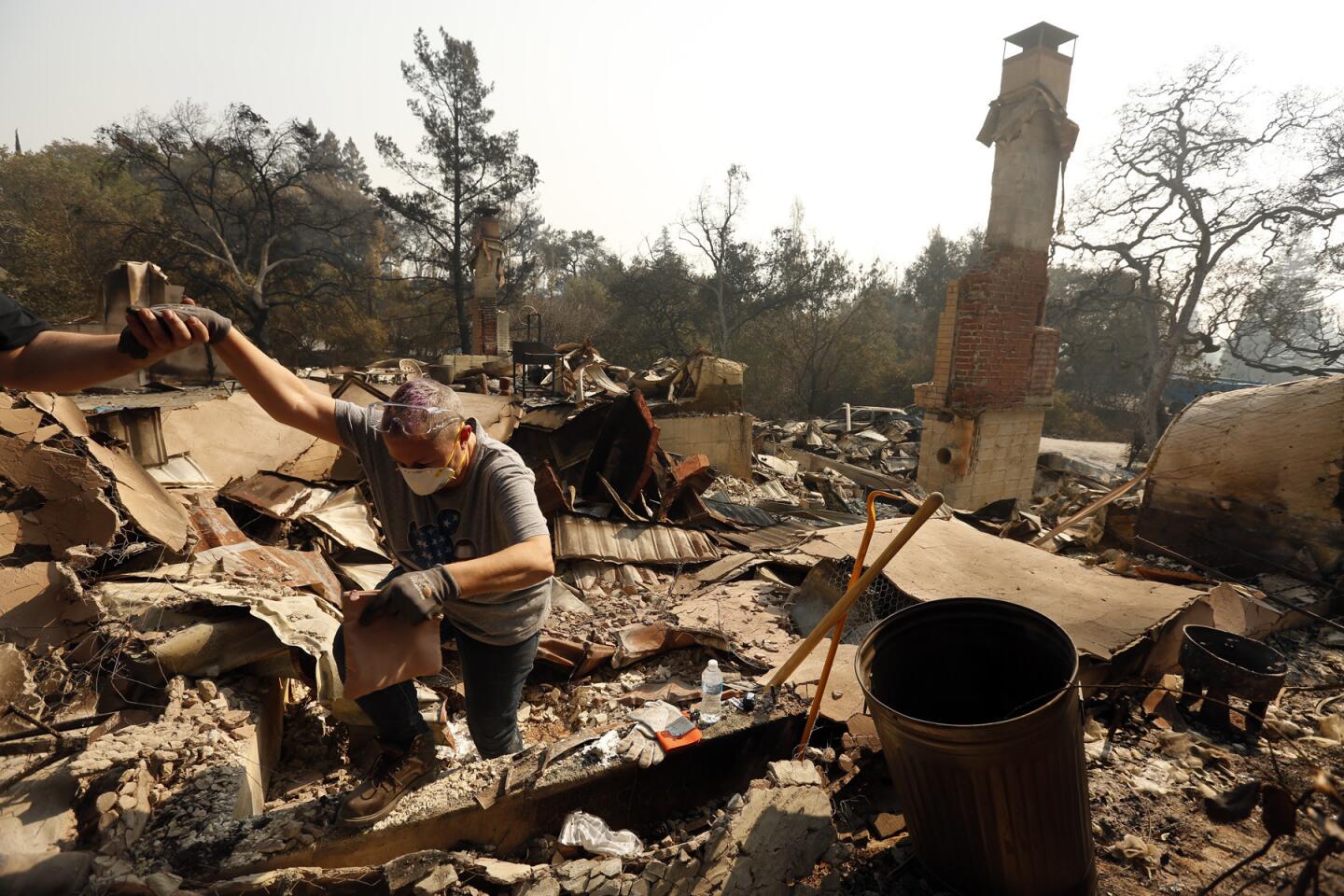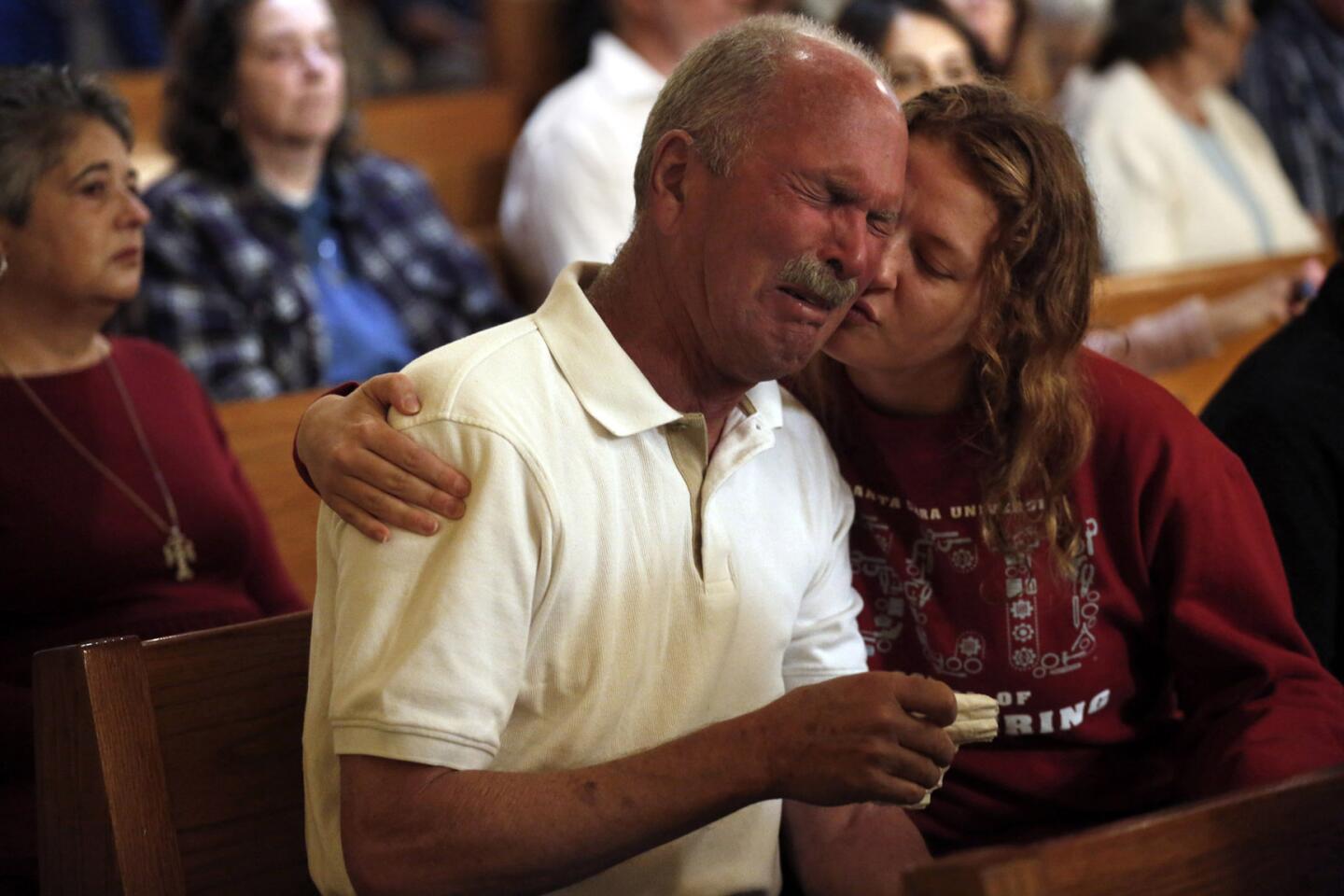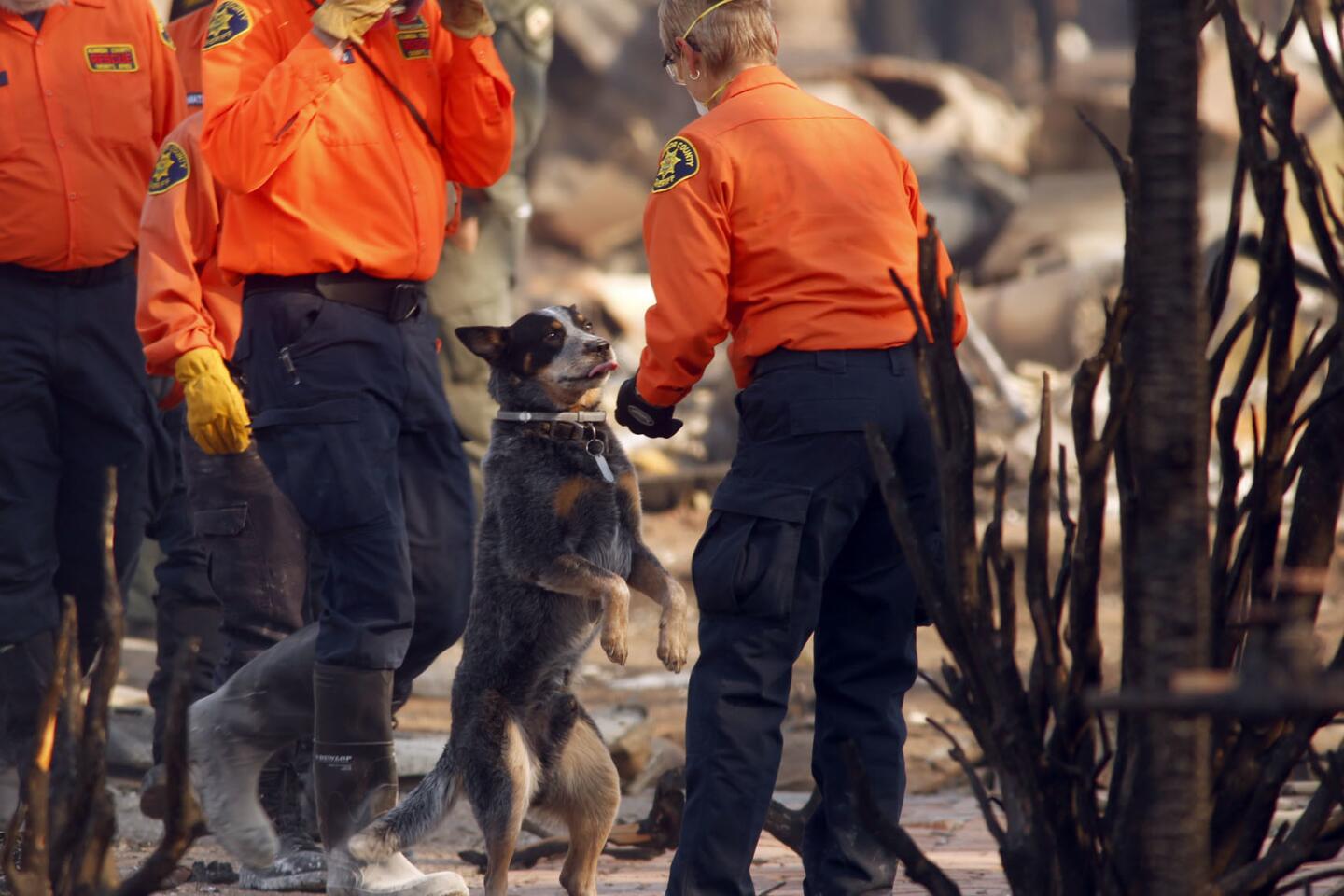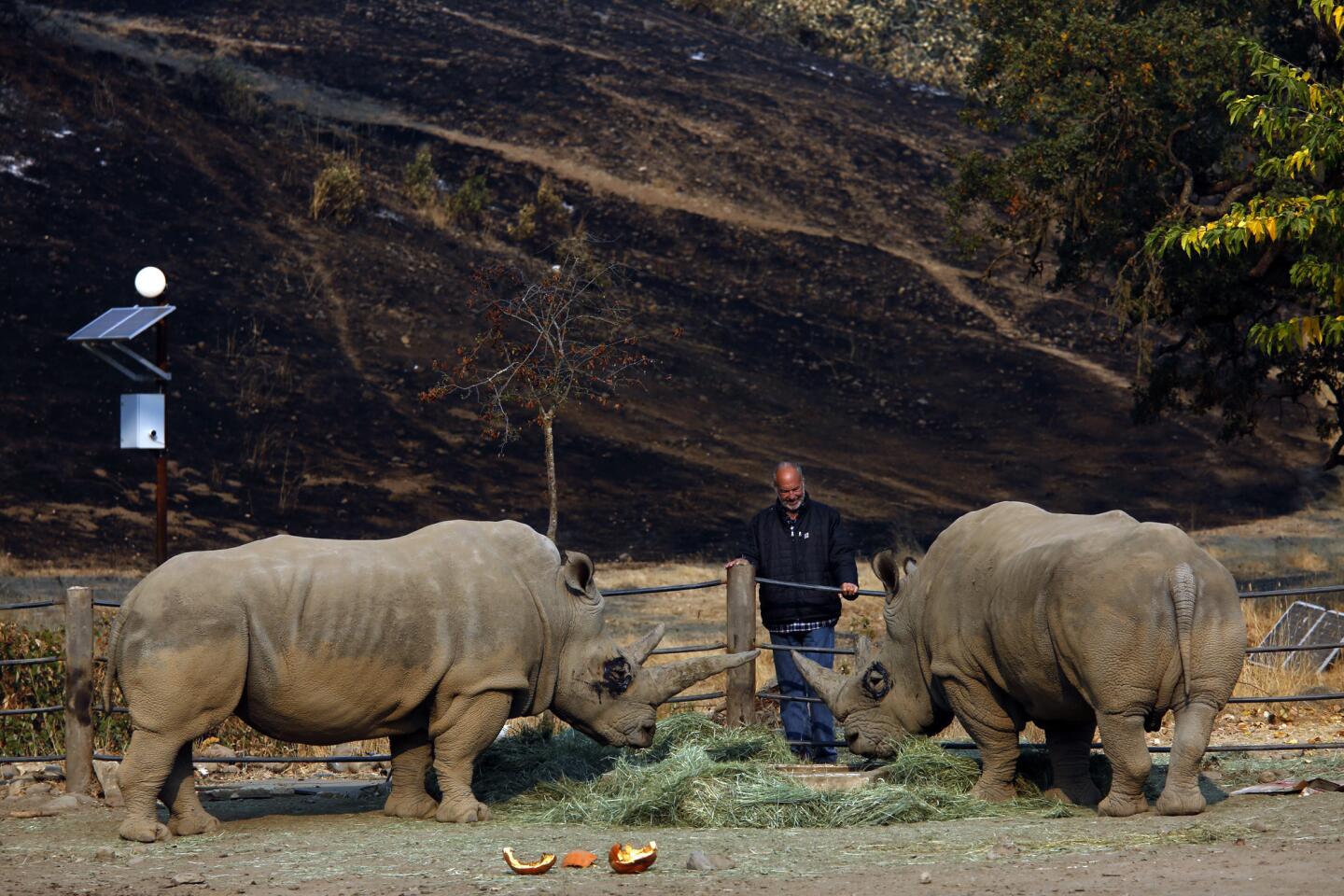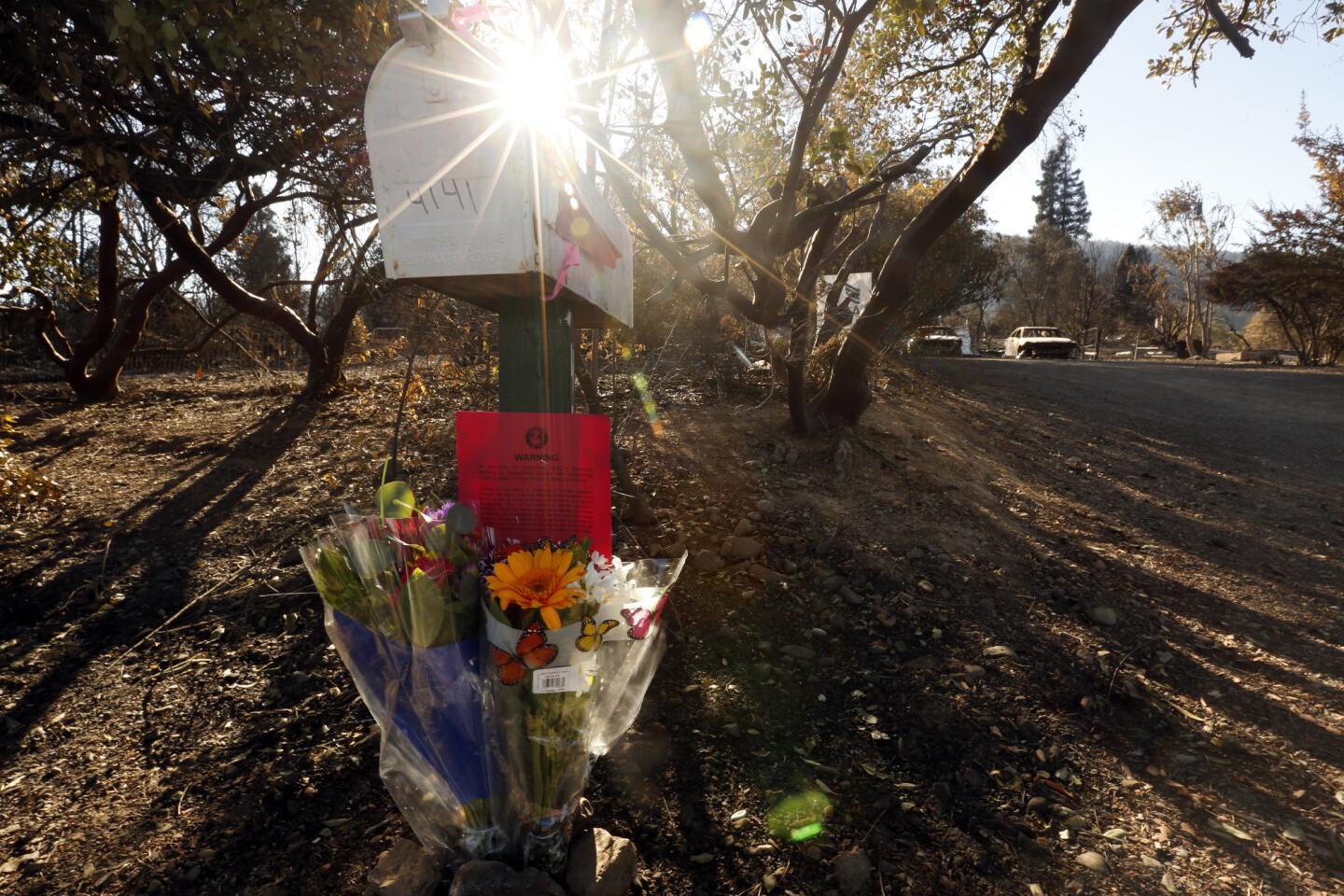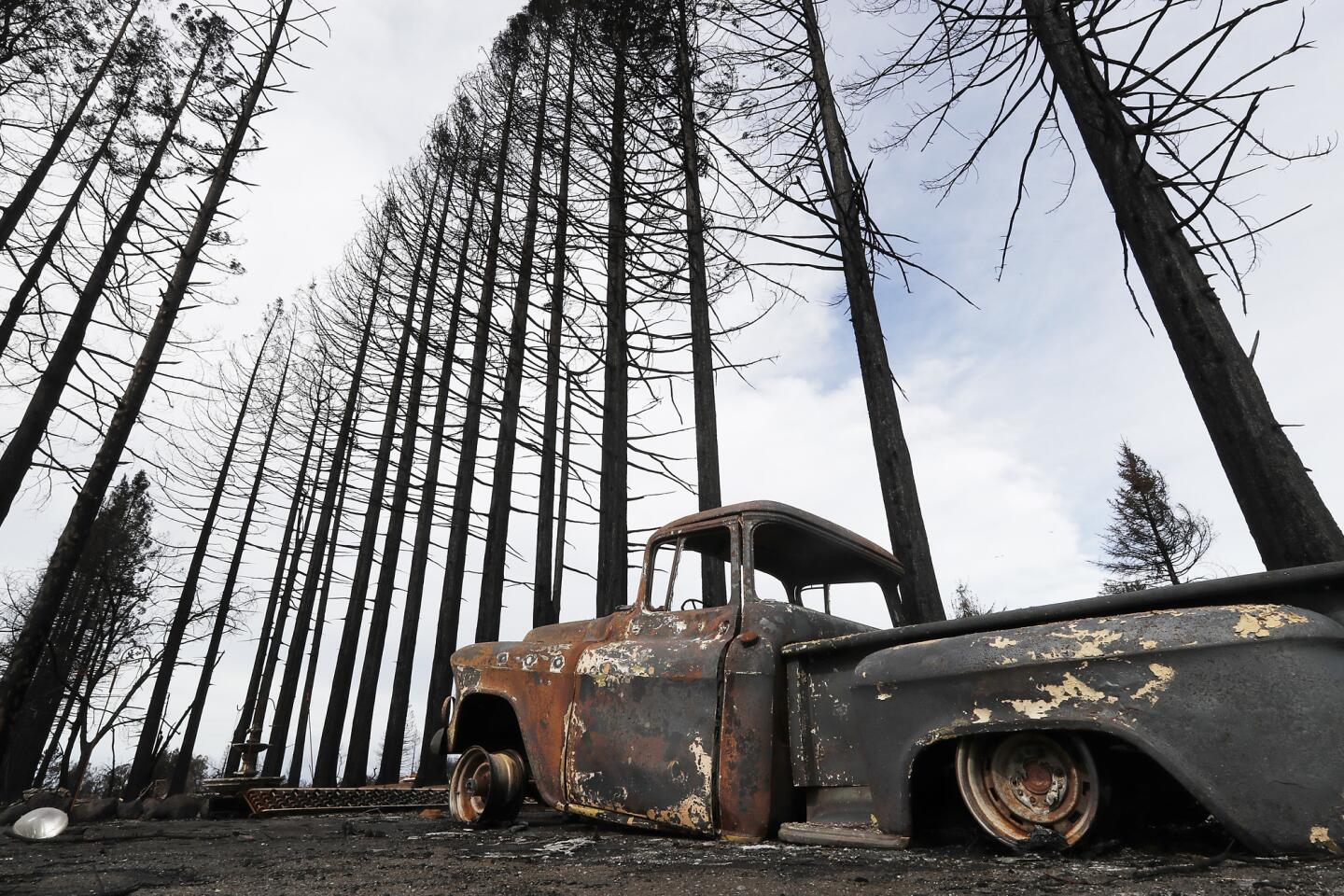Whole towns evacuated as Northern California firestorm grows; at least 23 people dead, 285 missing

Over 160,000 acres have been destroyed in northern California fires.
- Share via
Reporting from SANTA ROSA, Calif. — The death toll rose to 23 from the rapidly spreading firestorm in California wine country as officials issued more evacuations Thursday morning across the region.
With winds picking up, it was a tense night and early morning with an army of firefighter worked to keep the flames away from communities. Red-flag fire warnings were in place through Thursday afternoon.
All residents of Calistoga and Geyserville were ordered to leave their homes, two of numerous evacuation orders across the North Bay.
Napa city officials issued evacuation advisories for neighborhood s along the eastern edges of the city, warning residents to be prepared to leave. Just before 9 p.m., Santa Rosa police also issued an evacuation advisory for neighborhoods in the city’s eastern end, while other neighborhoods along the north end of the city are under mandatory evacuation orders.
“The fire is not an imminent threat, but the conditions may change quickly,” police said.
In Sonoma County alone, 25,000 people have evacuated, county spokesman Scott Alonso said late Wednesday.
Update: Weary fire crews make slight progress against deadly wine country fires >>
“If there’s been a mandatory evacuation, you cannot go home,” Alonso said. “The area is unsafe.”
Meanwhile, Sonoma County sheriff’s deputies are working to track down 285 out of 600 people reported missing. The rest — 315 people — have already been found safe. Alonso asked people to notify officials if they have found their missing loved ones.
Power remained out at 40,000 homes across the county.
A red flag warning forecasting dangerous fire conditions took effect Wednesday evening in the Bay Area. Weather officials expect strong winds with gusts as high as 50 mph. Combined with dry fuels and low humidity, fires have the potential to spread quickly, according to the National Weather Service.
The warning took effect at 5 p.m. in the North Bay Mountains and will take effect at 11 p.m. in the East Bay Hills, Santa Cruz Mountains and mountains in Monterey and San Benito counties.
“It’s a good heads-up to all the firefighters and emergency management that the conditions are going to be pretty bad in terms of the fire behaviors,” said Will Pi, a meteorologist with the National Weather Service. “We’re expecting the strongest winds to be tonight and tomorrow morning.”
State and federal officials portrayed an all-out effort to fend off the devastating wildfires at a news conference at a state emergency operations center outside Sacramento.
“It’s an extremely stressful and challenging time,” said Mark Ghilarducci, director of the Governor’s Office of Emergency Services. “We are all hands on deck.”
The situation remains very dangerous, officials said.
“We’re not going to be out of the woods for a great many days to come,” said Cal Fire director Ken Pimlott. The state is still feeling the effects of the drought despite a recent wet winter, and there’s “explosive vegetation” fueling the blazes.
“We’ve had big fires in the past,” Gov. Jerry Brown said. “This is one of the biggest.”
Officials said 13 people have died in Sonoma County, six in Mendocino County, two in Yuba County and two in Napa County.
Crews launched a desperate effort to extinguish key hot spots before heavy, fire-stoking winds could kick back up later in the day.
Officials fear that strong winds forecast for Wednesday evening and Thursday morning will spread embers from the deadly Tubbs fire to populated areas of Santa Rosa and Calistoga that have so far been spared the flames — and new evacuation orders were issued. Shelters opened for evacuees will not ask anyone’s immigration status, Sonoma County Sheriff Rob Giordano said.
“We are facing some pretty significant monsters,” Cal Fire incident commander Bret Gouvea told a room of about 200 firefighters and law enforcement officials at the Sonoma County Fairgrounds staging area Wednesday morning.
Exhausted and sore firefighters fanned across scorched mountainsides attacking hot spots, chopping shrubs and using shovels and axes to clear smooth paths down to bare soil roughly four feet wide as possible.
They were taking advantage of a lull in erratic winds to extinguish as many embers as possible and contain portions of fires burning out of control near populated areas before north winds were expected to pick up after midnight. Forecasts call for winds of up to 35 mph on mountaintops and heavily forested ridgelines north of Santa Rosa and Calistoga.
In a worst-case scenario, the winds would shoot embers into still-green terrain, igniting walls of flame that could march back into already devastated communities such as Santa Rosa.
“The clock is ticking, so we’re giving it everything we’ve got — hand crews, fire engines, bulldozers, air support — to keep the fire within the perimeter,” Cal Fire Division Chief Ben Nicholls said, while using a razor-sharp blade to slice through dry grass and stubborn roots.
“We like fighting massive fires,” he added. “A lot of what we’re doing isn’t that sexy. It’s called mop-up, and right now it is critical.”
Already, the Northern California fires have scorched an estimated 170,000 acres. The California Department of Forestry and Fire Protection estimates that around 3,500 structures have been destroyed.
On Wednesday night, “the return of the north wind will have a strong influence on the southern portions of the Tubbs fire,” a Cal Fire weather report said. “Winds will be 25 to 30 miles per hour after 2 a.m. These strong winds have the potential to push the fire south back towards Calistoga and Santa Rosa, especially where the fire was active yesterday [Tuesday] on the north side.”
On Wednesday, the Lake County Sheriff’s Office issued an advisory evacuation order for residents of Middletown — which was heavily damaged in the Valley fire just two years ago and rebuilt — as the Tubbs fire approached from the south.
Late Tuesday night, evacuations were ordered in Calistoga for the Tubbs fire, and in other areas of Napa and Sonoma counties for the Atlas Peak fire, the Nuns fire and the Pocket fire, officials said.
“The [Atlas] fire became active overnight, started burning more of the community,” Cal Fire spokeswoman Lynne Tolmachoff said.
Firefighters hoped to take advantage of the lull in the winds Wednesday morning and afternoon to attack hot spots and put out as many embers as possible before they can be revived and blown into areas that haven’t burned yet, they said.
By Wednesday evening, the Tubbs fire had reached about 28,000 acres and was 10% contained. Other fires ranging in size from 1,800 to 21,000 acres burned throughout the area and in surrounding counties.
Though some evacuation orders in Yuba and Nevada counties were lifted, officials estimated that upwards of 50,000 people were still out of their homes. More people in Sonoma and Napa counties were asked to leave their homes Tuesday night.
Napa County Supervisor Diane Dillon said Cal Fire commanders decided in the middle of the night to evacuate nearly half of the valley town of Calistoga, and by 3:30 a.m., Dillon and town officials along with police crews were walking house to house in the thick smoke, knocking on doors and telling occupants to leave.
“I was stunned to hear Cal Fire was recommending a massive, for Calistoga, evacuation,” Dillon said. “When we went out to talk, people were already leaving. People were alert to the situation.”
During a packed community meeting with emergency officials inside the Santa Rosa High School gym Tuesday evening, Sonoma County residents battered by the deadly wildfires were told that a red flag warning forecasting potentially hazardous fire conditions had been issued for Wednesday.
This comes after cooler weather allowed firefighters to gain ground Tuesday morning, only to see the flames flare up again with afternoon winds.
“This is nowhere near over. This is still very dangerous,” Sonoma County Sheriff Rob Giordano said Tuesday night.
Officials hope, though, that they won’t again face the 80 mph winds that stoked fires so quickly Sunday night.
In Mendocino County, where the Redwood and Potter fires have reached a combined 29,500 acres with 5% containment, one resident recalled the rush to get out in time.
It was just after 1 a.m. Monday when Jaime Lynn Lojowsky woke up to a pounding at the door.
“There is a fire on the mountain,” she heard her neighbor tell her husband. “It’s an emergency. It’s an emergency.”
Lojowsky, who lives in Redwood Valley with her husband, Mac, and two young girls, looked out her back window. Normally, she’d see bright stars, the moon peeking between the redwoods, pines and oak trees. It was one of the reasons why she’d moved from crowded and light-polluted Southern California more than a year ago.
This time, white smoke choked the night sky. The hillside was on fire. Flames licked the backyard of her 1-acre lot.
Lojowsky’s husband ran out the door to knock on neighbors’ doors to wake them, telling them to get out. One home had already caught fire.
The winds picked up. The flames raced toward them.
“Jaime, the house is going to go. What do you want to take?” he asked.
She had minutes.
On the outside, the couple tried to stay calm for 5-year-old Isabella. Lojowsky asked her to grab some things she’d like to take. Isabella grabbed her blanket and a stash of Halloween-themed toys.
On the inside, Lojowsky panicked.
“We’re going to die. I don’t want my babies to die like this,” she thought. “This can’t be happening.”
Lojowsky roused her youngest — 2-year-old Lourdes — from bed. She piled the girls into her Kia Sedona. They were met with a cloud of white smoke when she opened her garage door. Ash and fire rained down on the vehicle as she drove down the driveway and into the main road. Her husband followed in a truck behind them. About a mile down the road, a wall of flames blocked their path.
It was the main way out. She’d never gone the back way — a windy, dirt and gravel mountain road through a canyon.
Some cars barreled through the flames. Others went off the road.
She was uncertain on what to do. If she turned back, would she be met by a raging fire?
That’s when she spotted a Cal Fire truck. The crew directed her to go back through the mountain pass. It was safe, they reassured her. She turned back and drove past her home. She zoomed by her neighbor’s house and saw the cars still parked outside. She wondered if they’d make it out. They had three young boys.
“They have to leave now,” she thought.
Her car climbed up the mountain pass, tailing her husband’s truck. She called him on her cellphone, asking him to dial 911 to find out what they should do. She just wanted someone to tell her what to do or where to go.
The sky was still full of white smoke. She could see the flames in her rearview mirror. Lojowsky just kept driving, looking forward and keeping an eye on the gravel road speckled with potholes. Her vehicle weaved on a dirt road through a dense forest of redwoods, pines and oak trees. She could hardly see the road in front of her.
Ten minutes later, Isabella broke her silence.
“Great news, Mom. I can see the moon,” she said. “I can see stars.”
Lojowsky, who has fire insurance, would later discover that her house and farm had burned down. Only the brick fireplace remains of Lojowsky’s three-bedroom home. It’s unclear whether her chickens survived. But her family, two dogs and cats had made it out alive.
Fires in Northern an Southern Calif. create widespread damage, destroying homes and claiming live
Times staff writer Cindy Carcamo contributed to this report.
alene.tchekmedyian@latimes.com
ALSO
Desperate calls to save those trapped by fire, but emergency alert system failed many
Firefighters ‘pushing it to the limits’ as turbulent winds feed fires
A Santa Rosa synagogue becomes a haven in a firestorm
UPDATES:
5:10 a.m.: Updated with evacuations.
10:05 p.m.: This article was updated with missing person and evacuation numbers.
9:05 p.m.: This article was updated with evacuation advisories in Santa Rosa.
8:25 p.m.: This article was updated with mandatory evacuations in parts of eastern Sonoma Valley
8:15 p.m.: This article was updated to reflect that the Sonoma County sheriff said shelters will not ask for anyone’s immigration status.
7:40 p.m.: This article was updated with a new death toll and acreage figure, as well as a containment number on the Tubbs fire.
7:25 p.m.: This article was updated with new evacuation advisories, as well as information from the National Weather Service about dangerous fire conditions in the Bay Area.
6:14: This article was updated with new evacuations.
5:30 p.m.: This article was updated with new figures and color.
3:40 p.m.: This article was updated with new evacuation orders.
2:20 p.m.: This article was updated with color from scene.
12:35 p.m.: This article was updated with comments from Office of Emergency Services Director Mark Ghilarducci, Cal Fire head Ken Pimlott and Gov. Jerry Brown.
11:50 a.m.: This article was updated with a revised death toll for the Northern California wildfires.
10:55 a.m.: This article was updated with revised acreage and evacuation information.
9:30 a.m.: This article was updated with details about wind conditions.
This article was originally published at 7:05 a.m.
More to Read
Sign up for Essential California
The most important California stories and recommendations in your inbox every morning.
You may occasionally receive promotional content from the Los Angeles Times.









